121 - Lung Tumors in the Immunocompromised Host
Editors: Shields, Thomas W.; LoCicero, Joseph; Ponn, Ronald B.; Rusch, Valerie W.
Title: General Thoracic Surgery, 6th Edition
Copyright 2005 Lippincott Williams & Wilkins
> Table of Contents > Volume II > The Esophagus > Section XXIII - Benign Esophageal Disease > Chapter 139 - Congenital Anomalies of the Esophagus
Chapter 139
Congenital Anomalies of the Esophagus
Marleta Reynolds
Several investigators have challenged theories of the pathogenesis of esophageal anomalies. The classic theory, as presented by Gray and Skandalakis (1972), describes the ingrowth of mesodermal ridges to divide the foregut into trachea and esophagus. Error in fusion of these ridges results in various forms of tracheoesophageal fistulae (TEFs) (Fig. 139-1). O'Rahilly and Muller (1984) proposed that a TEF develops when an abnormal epithelium-lined connection forms between the developing esophagus and trachea. Kluth and colleagues (1987) present convincing data supporting the theory that the trachea and esophagus develop and divide from cranial, ventral, and dorsal folds of the foregut. The ventral fold divides the foregut into trachea and esophagus. Esophageal atresia with distal fistula results from excessive ingrowth of the dorsal fold and the formation of a proximal pouch. The cranial fold not meeting the ventral fold results in a fistula. Isolated esophageal atresia may result from the interruption of the blood supply to the esophagus, as seen in other forms of gastrointestinal atresia.
The lack of an experimental model had delayed the investigation of the pathogenesis of esophageal anomalies in the past, but Diez-Pardo and associates described a rodent model in 1996. Crisera and colleagues (1999), using the same model, suggested that esophageal atresia is secondary to vascular compromise of the developing foregut. In response, the lung bud develops a trifurcation instead of a bifurcation, with the middle branch descending to join the stomach. Their hypothesis can be used to explain the poor motility of the distal esophagus and the presence of cartilage in some distal esophageal stenoses.
ESOPHAGEAL ATRESIA AND TRACHEOESOPHAGEAL FISTULA
Incidence
Esophageal atresia was reported by Haight (1957) to occur in 1 in 4,500 births in the United States. Harris and colleagues (1995) reported a male-to-female ratio of 1.26, an increased risk with the first pregnancy, and a slight increase in rate with rising maternal age. They also found an increase in twin births and a 6% incidence of chromosomal anomalies in affected infants.
Associated anomalies occur in 50% to 70% of infants with esophageal atresia. Cardiac, genitourinary, gastrointestinal, and neurologic anomalies have been reported. Tracheobronchial anomalies were reported by Usui and co-workers (1996) to occur in 47% of infants with esophageal atresia. Choudhury and colleagues (1999) found associated cardiac anomalies to reduce survival with esophageal atresia from 88% to 59%. Quan and Smith (1973) coined the acronym VATER to describe infants with esophageal atresia and TEF, vertebral anomalies, imperforate anus, and renal and radial arm anomalies. When cardiac defects are also found, the acronym becomes VACTERL. Iuchtman and associates (1992) reported a mortality rate of 24% with this association. The cardiac abnormalities were the primary cause of death.
Several classification schemes have been used to describe the variants of esophageal atresia. Holder and colleagues (1964) reported the incidence of the most common variants of esophageal atresia (Fig. 139-2). Kluth (1976) collected every reported variation and created an atlas of esophageal atresia. Because of the number of variations, it is often easiest to describe the findings. Waterston and associates (1962) used risk factors to subdivide babies with esophageal atresia and to recommend treatment. The risk factors included birth weight, pneumonia, and associated congenital anomalies (Table 139-1). Patients in group A, or the good-risk category, underwent immediate repair. Those in group B (the moderate-risk group) had delayed repair. The high-risk infants in group C were managed with staged repair. Improvements in the care of small babies have made this classification obsolete. Spitz and associates (1994) reported that birth weight and major cardiac anomalies were predictors of survival and grouped babies with esophageal atresia based on these factors (Table 139-2). Babies in
P.2126
group I undergo immediate repair. Most in group II also undergo immediate repair unless a palliative cardiac procedure is emergently indicated. With the use of prostaglandin, this is seldom necessary. Even now, babies in group III can undergo immediate or delayed repair, and a staged repair is almost never indicated.
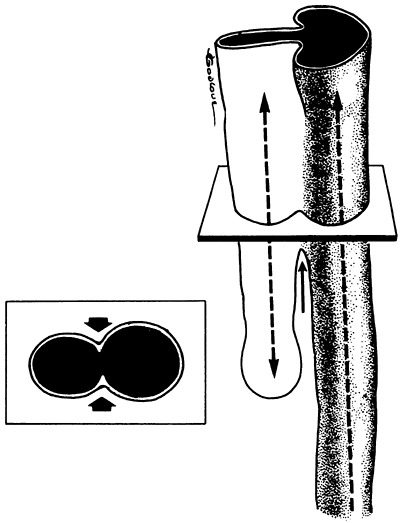 |
Fig. 139-1. Division of the primitive foregut, with stippled area showing the future esophageal portion. Arrows indicate the local morphogenic movements. From Gray SW, Skandalakis JE: Embryology for Surgeons: The Embryological Basis for the Treatment of Congenital Defects. Philadelphia: WB Saunders, 1972, p. 64. With permission. |
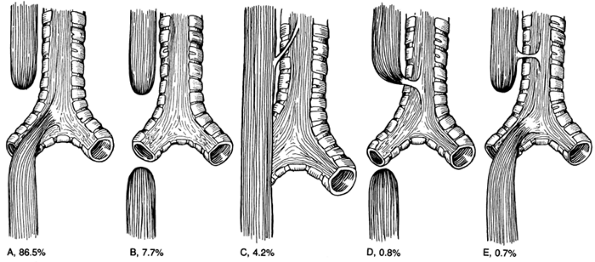 |
Fig. 139-2. A. Esophageal atresia with distal tracheoesophageal fistula. B. Esophageal atresia without tracheoesophageal fistula. C. Tracheoesophageal fistula without esophageal atresia. D. Esophageal atresia with proximal tracheoesophageal fistula. E. Esophageal atresia with both proximal and distal tracheoesophageal fistulae. |
Table 139-1. Waterston Risk Classification of Esophageal Atresia and Tracheoesophageal Fistula | |||||||||||||||
|---|---|---|---|---|---|---|---|---|---|---|---|---|---|---|---|
| |||||||||||||||
Clinical Presentation
The diagnosis of esophageal atresia can be made in the fetus by ultrasound examination. The findings of an absent or small stomach bubble in conjunction with maternal polyhydramnios is highly suggestive of esophageal atresia. Vijayaraghavan (1996) also noted that the presence of a fluid-filled pouch in the neck of the fetus helps to confirm the diagnosis. Stringer and associates (1995) found the sensitivity
P.2127
of prenatal ultrasound in making the diagnosis of esophageal atresia to be only 42%, with a positive predictive value of 56%.
Table 139-2. Survival Related to Birth Weight and Major Congenital Heart Disease, 19807ndash;1994 | |||||||||||||||||||||||||||||||||||
|---|---|---|---|---|---|---|---|---|---|---|---|---|---|---|---|---|---|---|---|---|---|---|---|---|---|---|---|---|---|---|---|---|---|---|---|
| |||||||||||||||||||||||||||||||||||
Most babies with esophageal atresia present shortly after birth with excessive drooling. The astute neonatal nurse observes difficulty with the first feeding, choking, coughing, and even cyanosis. Early diagnosis can prevent the pulmonary complications that quickly develop. Aspiration of oral secretions from the proximal pouch can be prevented by passage of a tube designed by Replogle (1963) attached to continuous suction. If a distal fistula is present, the stomach quickly fills with air. Reflux of gastric secretions into the tracheobronchial tree may lead to chemical pneumonitis. As the abdomen gets more distended, elevation of the diaphragm may further compromise the baby's respiratory status.
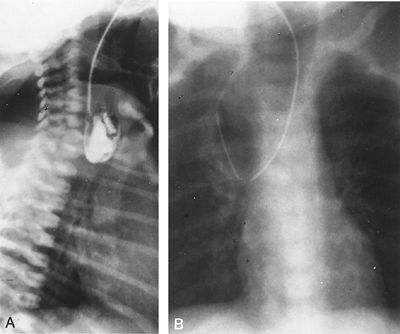 |
Fig. 139-3. A. Esophagogram of an infant with esophageal atresia; barium outlines the proximal pouch. B. Radiograph of an infant with esophageal atresia. Air distends and outlines the proximal pouch. |
Diagnosis
The diagnosis of esophageal atresia is made when a catheter placed in the proximal esophagus cannot be advanced into the stomach. A plain radiograph of the chest confirms the position of the catheter in the upper mediastinum near T1 or T2. Air can be injected through the catheter into the proximal pouch to better outline the pouch. Water-soluble contrast can be dripped into the proximal pouch with fluoroscopic observation to search for a proximal fistula. Barium should not be used by the inexperienced because of the risk of barium aspiration (Fig. 139-3). The incidence of a proximal fistula is so low that many forego this diagnostic study and carefully examine the proximal pouch for a proximal fistula at the time of repair.
A babygram, which includes the neck, chest, and abdomen, is used to diagnose a distal fistula because the stomach and intestines have air throughout. The radiograph is also used to identify any associated anomalies of the heart, intestines, and vertebral column. The location of the aortic arch is important to some when planning the operative approach. If it is difficult to see on the plain radiograph, high-kilovolt images (Fig. 139-4) or echocardiography (Fig. 139-5) can be used. Canty and colleagues (1997) demonstrated an association of long-gap esophageal atresia (>3 cm between proximal and distal esophagus) with aortic arch anomalies. They recommend computed tomographic (CT) or magnetic resonance (MR) imaging if a right-sided arch is identified because a vascular ring may need to be addressed
P.2128
at the time of esophageal repair and a left thoracotomy considered. The echocardiogram is also used to identify associated congenital heart disease.
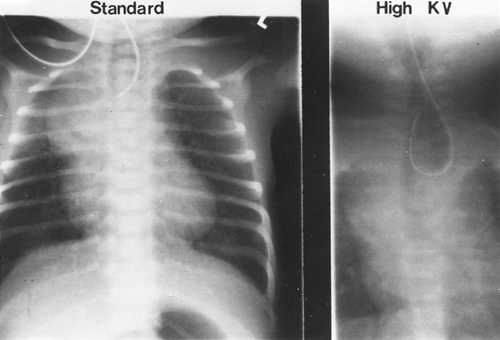 |
Fig. 139-4. Standard and high-kilovolt radiograph of an infant with esophageal atresia. The high-kilovolt radiograph shows deviation of the trachea to the right, indicating a left aortic arch. From McKneally MF, et al: Surgical treatment of congenital esophageal atresia. Ann Thorac Surg 38:606, 1984. With permission. |
The diagnosis of an H-type TEF without esophageal atresia is often made late and with difficulty. A high index of suspicion and an experienced radiologist are needed. Water-soluble contrast or barium is slowly dripped into the proximal esophagus, and using fluoroscopic observation, the communication between the trachea and esophagus is identified in the lower neck and upper chest. Bronchoscopy with meticulous examination of the posterior wall of the proximal trachea can be used to make or confirm the diagnosis.
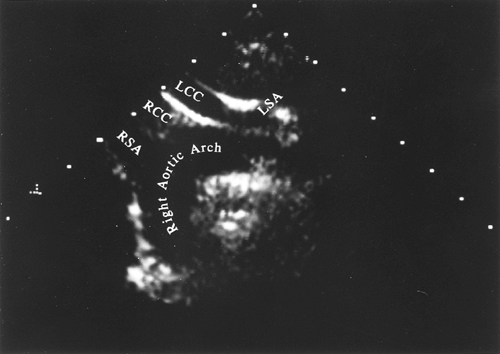 |
Fig. 139-5. An echocardiogram showing a right-sided aortic arch. LCC, left common carotid artery; LSA, left subclavian artery; RCC, right common carotid artery; RSA, right subclavian artery. |
ESOPHAGEAL ATRESIA WITH DISTAL FISTULA
Initial Management
A thorough examination and evaluation of the baby with esophageal atresia with distal fistula should be completed before surgery. The initial babygram may identify duodenal atresia with the classic double-bubble sign. Imperforate anus can be ruled out with an inspection of the perineum and rectal examination. A cardiac echocardiogram and a renal ultrasound are excellent screening tools for associated anomalies.
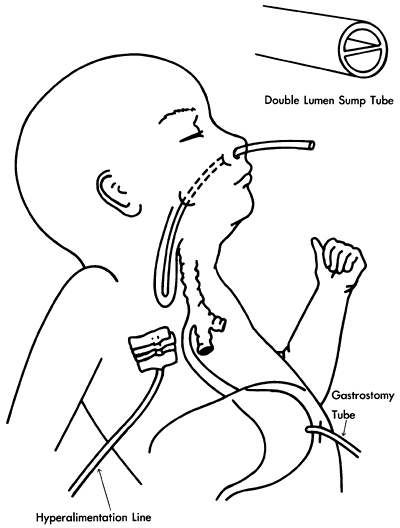 |
Fig. 139-6. Replogle double-lumen sump catheter designed to decompress the proximal pouch in infants with esophageal atresia. Adapted from Replogle RL: Esophageal atresia: plastic sump catheter for drainage of the proximal pouch. Surgery 54:296, 1963. With permission. |
P.2129
In the past, timing of surgical correction was based on the Waterston classification (see Table 139-1). Improvements in perinatal care have made it possible to perform primary repair in smaller and smaller babies. Coexisting conditions, especially congenital heart disease and physiologic status, now dictate the timing and type of surgical repair. In the unstable baby, the proximal pouch is drained with the Replogle tube, and a gastrostomy tube and central line are placed (Fig. 139-6). The delayed repair is performed as soon as the baby's condition permits. A staged repair, which consists of division of the fistula and delayed repair, is almost never indicated and would be reserved for babies too sick to tolerate repair but in whom ventilation is impossible without division of the fistula.
Operative Repair
A right posterior thoracotomy and extrapleural approach is used to expose the esophagus and trachea. The pleura is reflected medially with blunt dissection, and the azygos vein is identified and divided. The distal esophagus and vagus nerves are immediately visualized. The fistula is usually located beneath the azygos vein, and the distal esophagus enters the membranous trachea just above the carina. It can communicate with a major bronchus or higher in the trachea. The distal esophagus is isolated with a vessel loop, and the fistula is identified. The fistula is divided and the trachea closed with 6-0 or 7-0 absorbable sutures. The tracheal closure is covered with pleura, the stump of the azygos vein, or other tissue nearby.
The proximal esophagus is located by downward pressure on the pouch applied with an esophageal stethoscope by the anesthesiologist. The proximal pouch is dissected free from adjacent tissue and incised at its tip. Davies (1996) cautions that extensive dissection of the proximal pouch leads to disruption of the nerve supply to the esophagus and may be responsible for subsequent problems with esophageal motility. Once the proximal pouch is opened, an undetected proximal fistula should be apparent if air bubbles into the proximal pouch from the trachea. If present, a proximal fistula also must be divided from within the chest or the neck (Fig. 139-7). The small catheter is passed down
P.2130
the distal esophagus to ensure patency. The proximal and distal esophagus are approximated with a single-layer, end-to-end anastomosis using absorbable suture. The anesthesiologist passes a small silicone polymer (Silastic) catheter through the nose and advances it through the anastomosis before the surgeon ties the last suture. This provides a route for enteral feedings in the early postoperative period.
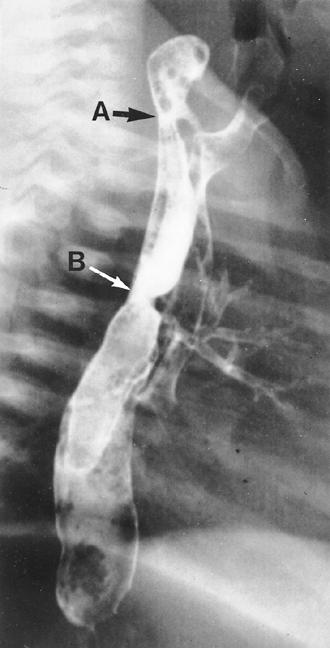 |
Fig. 139-7. Esophagogram illustrating a high proximal fistula (A) that was missed at previous repair of esophageal atresia with distal tracheoesophageal fistula (B). |
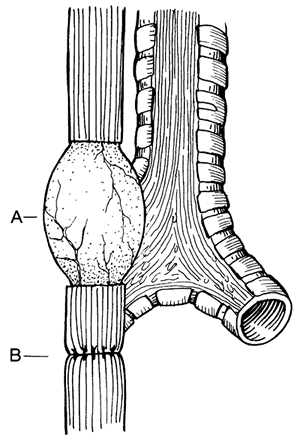 |
Fig. 139-8. Esophageal myotomy (A) performed to increase the length of the proximal pouch to relieve tension on the esophageal anastomosis (B). |
If the distance between the proximal and distal esophagus precludes a tension-free anastomosis, a myotomy can be performed. Single or multiple circular myotomies, as popularized by Livaditis and colleagues (1972) and de Lorimier and Harrison (1980), can be performed to lengthen the proximal pouch (Fig. 139-8). Kimura and associates (1987) were proponents of a spiral myotomy to accomplish the same goal (Fig. 139-9). Although seldom necessary, either technique can be useful in the rare patient with a long gap between the two ends of the esophagus.
Before closing the chest, an 8F or 10F soft catheter with extra drainage holes is placed near the anastomosis and brought out of the chest through a separate incision. This is connected to water-seal drainage.
Postoperative Care
Attempts are made to extubate the baby in the operating room or as soon as possible in the newborn intensive care unit. To loosen secretions, these babies are kept in an isolette with high humidity. Deep suctioning is forbidden. Right upper lobe collapse occurs frequently but responds to gentle-vibration physiotherapy. Occasionally, laryngoscopy and direct aspiration of the trachea by the surgeon who has direct knowledge of the location of the tracheal suture line is helpful. Intravenous fluids are continued, as well as perioperative antibiotics. Feedings are started through the nasogastric catheter after the baby stabilizes in 24 to 36 hours.
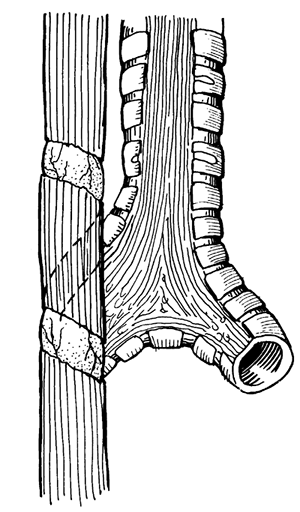 |
Fig. 139-9. Spiral myotomy is an excellent technique for increasing the length of the proximal pouch to avoid excessive anastomotic tension. |
A barium swallow can be obtained after 5 to 7 days to identify an anastomotic leak or stricture (Fig. 139-10).
P.2131
Nambirajan and associates (1998) have shown the barium swallow to have little value in planning subsequent care. They found that a radiologic leak did not alter management or outcome, and identification of an anastomotic stricture did not correlate with the need for dilation based on symptoms. The symptomatic stricture can be dilated after 2 to 3 weeks. If a 3.5-mm catheter cannot be passed through the esophageal anastomosis, I place a gastrostomy tube and pass a silicone polymer string through the anastomosis, out the nose, and into the stomach to form a complete circle. The string is used to pass serial Tucker dilators with the silicone tube as a guide. Balloon dilation under fluoroscopic guidance can also be used to dilate a significant stricture (Fig. 139-11).
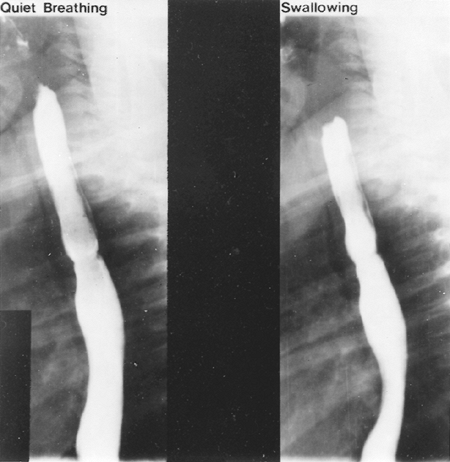 |
Fig. 139-10. Esophagogram performed 7 days after repair of esophageal atresia and distal tracheoesophageal fistula. No barium clearance with swallowing indicates poor esophageal motility. |
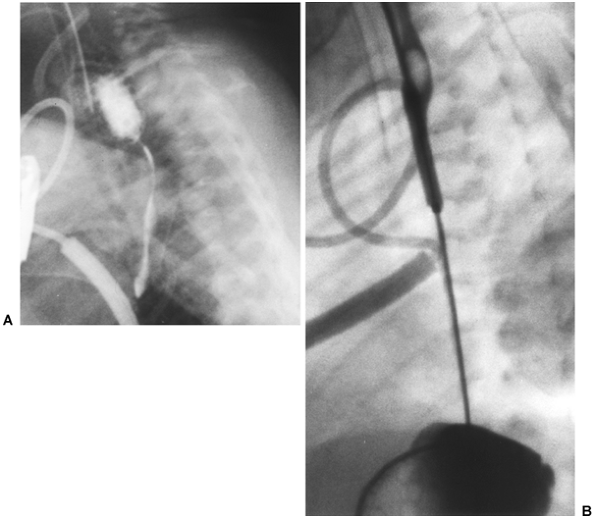 |
Fig. 139-11. A. Barium swallow demonstrates an anastomotic stricture 2 weeks after primary repair of esophageal atresia and tracheoesophageal fistula in a premature infant with pulmonary atresia. B. A 3-mm balloon was used to dilate the stricture. Repeated dilations using larger balloons were successful in establishing a widely patent esophagus. |
ESOPHAGEAL ATRESIA WITHOUT TRACHEOESOPHAGEAL FISTULA
Babies with isolated esophageal atresia present with the symptoms of excessive drooling, coughing, and choking. Physical examination reveals a scaphoid abdomen, and the babygram shows no air in the gastrointestinal tract. Air or water-soluble contrast injected into the proximal pouch documents the length of the proximal pouch. The esophagus is usually shorter than that found in infants with an associated TEF. Although rare, a proximal fistula may be present, and the contrast study can be used to identify the fistula.
A gastrostomy is always done to provide a route to begin enteral feedings, and a radiograph of the stomach and duodenum
P.2132
can be done at the time to rule out an associated duodenal atresia. Evaluation of the distal esophagus with a postoperative barium study can help to estimate the gap between the proximal and distal esophagus and to plan treatment.
Long-gap esophageal atresia is defined as a distance greater than 3 cm between the proximal and distal esophagus. Counting the number of vertebral bodies between the two can also be descriptive. If the surgeon determines that the distance between the two ends of the esophagus will not allow a relatively tension-free anastomosis, a delayed repair or esophageal substitution must be considered. Many different methods to elongate the upper pouch have been described. The technique most frequently used is upper pouch bougienage. Described by Howard and Myers (1965), the technique entails placing a weighted bougie through the mouth into the proximal pouch and applying constant pressure for a few minutes several times a day. The daily dilations should elongate the upper pouch within 6 to 12 weeks and allow delayed repair. If no progress is being made, esophageal replacement may be necessary.
Operative Approach
A right thoracotomy with extrapleural dissection is used to approach the esophagus. After the proximal and distal esophagus are identified, myotomies can be performed to further lengthen the proximal pouch. An end-to-end anastomosis with absorbable sutures is attempted. If the two ends cannot be brought together, a cervical esophagostomy should be created and plans made for esophageal replacement. Sham feedings can be started so the infant does not forget how to eat by mouth. Esophageal replacement is discussed in Chapters 132, 133, and 134. The most widely used techniques in infants and children are the colon interposition and reversed gastric tube.
TRACHEOESOPHAGEAL FISTULA WITHOUT ESOPHAGEAL ATRESIA
Holder and colleagues (1964) reported the incidence of TEF without esophageal atresia as 4.2%. Fewer associated anomalies are reported in this group of children. The diagnosis may be delayed until adolescence or early adulthood. A history of choking and coughing with feeding since birth can usually be obtained. As the children get older, symptoms only occur with liquid ingestion. Occasionally, there is a history of abdominal distention and excessive flatus caused by air entering the esophagus through the fistula.
The fistula is most often located in the lower neck or upper thorax at or above T2. A barium swallow with careful examination of this area is recommended. A small catheter can also be passed into the proximal esophagus and barium carefully dripped into the proximal esophagus to identify a wisp of barium passing into the trachea. Care must be taken to avoid laryngotracheal aspiration. If the results of the barium study are negative and the index of suspicion high, bronchoscopy and esophagoscopy may be helpful. Careful inspection of the proximal posterior wall of the trachea usually uncovers the fistula. In an older child, simultaneous flexible esophagoscopy can be performed and methylene blue instilled into either the trachea or esophagus and identified in the other.
The TEF is often referred to as an H-type fistula, but it is in fact shaped like the letter N, with the tracheal end being higher than the esophageal end. Because of this relationship, small amounts of liquid pass between the trachea and esophagus, and the fistula can be temporarily plugged with mucus. This leads to delay in diagnosis.
Operative Approach
After general anesthesia, a ureteral catheter is passed through the trachea into the esophagus using the bronchoscope. The catheter is then retrieved from the esophagus and manipulated by the anesthesiologist during the operation. A right cervical incision is made and the esophagus retracted laterally. The recurrent laryngeal nerve is identified and spared any direct trauma or thermal injury. Locating the fistula can be facilitated by gentle traction on the ureteral stent. The fistula is isolated and divided and the stent removed. The esophagus and tracheal ends are closed, and local muscle or soft tissue is interposed between the two to help prevent recurrence.
Complications
Complications of repair of esophageal atresia with or without TEF are numerous. Complications can occur early or late, and for this reason, lifelong surveillance of these patients is necessary. Early complications involve the esophagus or trachea and include anastomotic leaks, stricture, recurrent TEF, tracheomalacia, aspiration, and gastroesophageal reflux.
Anastomotic Leak
Most anastomotic leaks are tiny and are not clinically significant. Observation is all that is necessary because most will seal without intervention. A major disruption of the esophagus causes acute deterioration in the baby's clinical status because of the resultant tension pneumothorax. Thoracotomy is required to try to repair the anastomotic disruption and provide adequate drainage of the contaminated space. If the esophagus cannot be repaired, a cervical esophagostomy should be done and esophageal replacement planned. Tsai and colleagues (1997) reported anastomotic leak in 11% of patients treated with primary or delayed repair and in 54% of those treated with staged repair.
P.2133
Anastomotic Stricture
Anastomotic strictures were reported by Engum (1995) and Tsai (1997) and their associates to occur in 35% to 39% of infants with TEF with esophageal atresia. Tsai defined a stricture as the presence of an anastomotic narrowing requiring at least two dilations. There was no difference in rate of stricture when primary, delayed, or staged repairs were considered. The stricture rate was higher in infants who developed an anastomotic leak.
Most strictures can be treated with a few sequential dilations (Fig. 139-12). Prograde dilations with Tucker or Maloney dilators are usually successful. If the dilator cannot be passed blindly, a silicone polymer (Silastic) string can be passed through the anastomosis and serve as a guide. Balloon dilation offers the advantage of producing a uniform and radial force at the stricture site and is advocated by Allmendinger and associates (1996). A stricture that does not respond to serial dilations may be adversely affected by severe gastroesophageal reflux (GER). Documentation and aggressive treatment of GER must coincide with dilations. If medical therapy cannot control GER, an antireflux procedure may need to be considered.
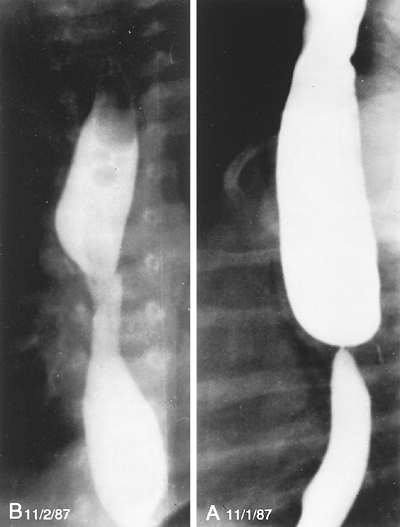 |
Fig. 139-12. A. Esophagogram 6 weeks after repair of esophageal atresia with distal tracheoesophageal fistula. A tight stricture is seen at the anastomosis. B. Esophagogram 24 hours after dilation. |
Recurrent Fistula
Recurrent TEF was identified in 3% of patients reported by Engum and colleagues (1995). All were treated by reoperation, division of the fistula, and interposition of tissue between the trachea and esophagus. Tsai and associates (1997) reported a 2.5% incidence of missed fistula. The missed fistula is usually proximal in location and is divided using a cervical incision.
Tracheomalacia
All infants with esophageal atresia have some tracheomalacia. Their barking cough is characteristic and can be alarming to some. The tracheomalacia may become symptomatic, especially when the infant swallows a large bolus of food. Posterior compression of the already weak tracheal wall may compromise the airway. Tracheostomy is occasionally indicated for the infant with very severe tracheomalacia. Most of the time, the tracheomalacia is minor, and parental reassurance is all that is needed because most infants will improve over time.
Aspiration
Aspiration with laryngospasm and near death spells can occur in babies with esophageal atresia. It is often difficult to sort out the cause, but a thorough examination, careful history, and appropriate studies should be initiated. Laryngoscopy is useful in identifying the infant who has developed postoperative vocal cord paresis or paralysis. This is more common in children with an isolated TEF but has also been seen with repaired esophageal atresia. Overzealous dissection of the proximal pouch leads one into proximity with the recurrent laryngeal nerve as it passes between the trachea and esophagus. Unilateral vocal cord paresis or paralysis may require alterations in feeding practices, and a rehabilitation study can identify what the infant or child can or cannot eat without aspiration. A barium esophagogram should also be obtained to rule out an undiagnosed stricture causing pooling of secretions and food in the proximal pouch and to rule out a missed or recurrent fistula.
Gastroesophageal Reflux
GER can be associated with aspiration, and a pH probe or endoscopy may be indicated for confirmation of the GER. GER was reported by Engum and associates (1995) to occur in 58% of their patients. Medical treatment was successful in 56%, and the remainder required surgical intervention. Bergmeijer and Hazebroek (1998) followed a strict protocol to prospectively evaluate and treat GER in babies with esophageal atresia. They found significant improvement with medical treatment, although surgery was
P.2134
necessary to control severe reflux. Nissen fundoplication is the most common procedure used for treatment of GER in children. In the setting of patients with esophageal atresia, however, it has a high failure rate. Snyder and colleagues (1997) reported their experience with a partial wrap fundoplication or Thal fundoplication. Satisfactory results were achieved in 85%. Regardless of technique, medical therapy should be exhausted before fundoplication is recommended, because the esophageal motility is already abnormal and the fundoplication will slow down esophageal emptying considerably.
Results of Treatment
Long-term survival has improved over the past 50 years for babies with esophageal atresia. Manning and associates (1986) reported a large series and found the survival rate to be 36% before 1950 and 84% during the 1970s and 1980s. Choudhury and associates (1999) reported a 78% survival rate for patients treated from 1980 to 1997. Associated congenital heart disease played a major role in survival, with 88% surviving without heart disease and only 59% surviving with congenital heart disease. Birth weight did not affect outcome in their series, but chromosomal abnormalities played a role in the death of some infants. Advances in neonatal care, improved operative techniques, and meticulous attention to complications have improved the survival of infants with esophageal atresia. Although there is still room for improvement, interest is increasing in prevention strategies and fetal treatment considerations.
CONGENITAL LARYNGOTRACHEOESOPHAGEAL CLEFT
A laryngotracheoesophageal cleft is secondary to the failure of the lateral side of the cricoid cartilage to fuse in the midline with lack of advancement of the tracheoesophageal septum. At least one-half of affected babies have associated anomalies, the most common being esophageal atresia and TEF.
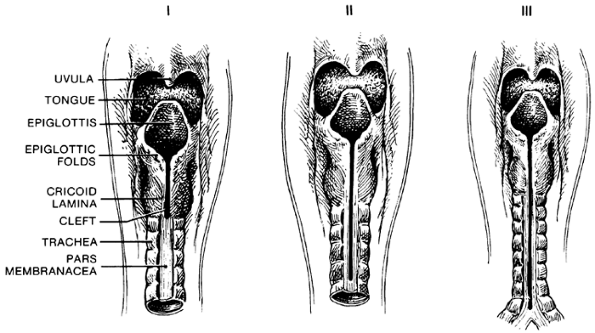 |
Fig. 139-13. Congenital laryngotracheoesophageal clefts. |
Originally described by Richter in 1792, the laryngotracheoesophageal cleft was later classified by Pettersson (1955) into three subtypes (Fig. 139-13): type I is described as a split in the cricoid cartilage; type II is a split from the arytenoid notch down to include several cartilages; and type III extends down to the carina. Ryan and colleagues (1991) described a type IV cleft with extension into one or both major bronchi (Fig. 139-14).
Babies with laryngotracheoesophageal cleft present with the same symptoms as a baby with esophageal atresia (Table 139-3). Problems with breathing at feeding time occur in more than one-half of babies. The typical baby has increased salivation, stridor, and a low-sounding cry. A plain radiograph of the neck and chest may show displacement of an orogastric tube anteriorly and an endotracheal tube posteriorly.
A barium swallow is a good screening test for laryngotracheoesophageal cleft. It shows the immediate aspiration of contrast into the trachea. It may be impossible to distinguish a high TEF from the cleft. Endoscopy is required to confirm the diagnosis and identify the type.
Several techniques have been described to correct the laryngotracheoesophageal cleft. Types I and II can be approached through a lateral pharyngoesophagotomy and repaired with two flaps. Evans and colleagues (1995) describe an endoscopic repair using an operating microscope, suspended laryngoscope, and modified microlaryngeal instruments. The anterior cervical approach can also be used and avoids injury to the recurrent laryngeal nerve, which is a well-documented complication of the lateral approach. Type III clefts are usually repaired with the lateral cervical approach and right thoracotomy. Lipshutz and colleagues (1998) recommend the anterior approach without thoracotomy. Evans and colleagues (1995) advocate the anterior approach with median sternotomy and cardiopulmonary bypass for types III and IV. Simpson and colleagues (1996)
P.2135
used an anterior or right cervical incision and partial sternotomy to correct type IV clefts. Tracheotomy or prolonged intubation is usually required postoperatively. GER is common in these patients and should be investigated preoperatively. Hof and associates (1987) recommend fundoplication before reconstruction because of the effects of reflux on the repair.
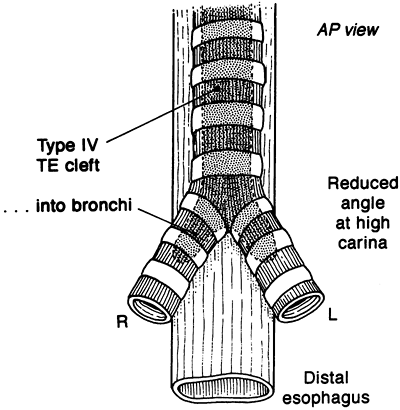 |
Fig. 139-14. Type IV laryngotracheoesophageal cleft. From Simpson BB, et al: Type IV laryngotracheoesophageal clefts: surgical management for long-term survival. J Pediatr Surg 31:1128, 1996. With permission. |
Recurrent TEF seems to plague these patients after repair. Evans and associates (1995) reported 30 infants surgically treated for laryngotracheoesophageal clefts, of whom 8 patients (18%) required revision. In this series, 6 patients died (14%). Simpson and colleagues (1996) reported a series of infants with type IV clefts and a 50% mortality. Delay in diagnosis, associated anomalies, and complications of surgical repair have contributed to this high mortality rate.
Table 139-3. Incidence of Leading Symptoms of Laryngotracheoesophageal Cleft in Newborn and Young Infants | ||||||||||||||||||
|---|---|---|---|---|---|---|---|---|---|---|---|---|---|---|---|---|---|---|
| ||||||||||||||||||
CONGENITAL ESOPHAGEAL STENOSIS AND ESOPHAGEAL DIAPHRAGM (ESOPHAGEAL WEB)
Although esophageal stenosis in infancy may result from a congenital abnormality, stenosis is far more commonly an acquired lesion related to esophageal mucosal injury. The common causes of esophageal stenosis are related to reflux esophagitis, caustic chemical ingestion, or trauma from foreign bodies.
Three types of congenital esophageal stenosis have been described: (a) segmental hypertrophy of the muscularis and submucosal layers of the esophageal wall, (b) membranous web or diaphragm, and (c) intramural rests of cartilaginous tracheobronchial tissue. The etiology of segmental hypertrophy is poorly understood but may be related to a remnant of a perforated membranous web.
The development of an esophageal web, similar to other mucosal diaphragms of the gastrointestinal tract, is associated with not recanalizing the lumen after the temporary solid cord stage at 10 weeks' gestation. Using wax models, Johnson (1910) and Bremer (1944) theorized that not recanalizing the lumen of the esophagus is the probable cause of esophageal web. Histologically, segmental hypertrophy and mucosal web contain only submucosal and mucosal components rather than the muscular wall of the esophagus.
Frey and Duschel (1936) were the first to report the occurrence of tracheobronchial remnants in the esophagus. In the developing embryo, the respiratory diverticulum (lung bud) forms during the fourth week (see Chapter 2). A tracheoesophageal septum forms from cellular proliferation from lateral ridges originating in the lateral walls of the foregut between the diverticulum and the esophagus. With the subsequent cranial elongation of the esophagus and respiratory tree, it is conceivable that mesenchymal cells of the respiratory diverticulum may become embedded in the wall of the developing esophagus. The remnant of tissue consists of respiratory seromucinous glands, respiratory epithelium, and crescent-shaped mature cartilage. The extrinsic compression of the heterotopic tissue and the inelasticity of the cartilage result in a stenotic lumen. Azimi and O'Hara (1973), Jewsberry (1971), Murphy and co-workers (1995), Sidaway (1964), and Stephens (1970) have reported various web and tracheobronchial remnants associated with esophageal atresia with and without TEF.
Clinical Presentation
The clinical presentation of a complete esophageal web is similar to that of esophageal atresia. Symptoms include excessive salivation, choking spells, and respiratory distress. Inability to pass a catheter into the stomach confirms
P.2136
the diagnosis. The infant with a web almost always presents in the newborn period. Babies with a ruptured or incomplete web, segmental hypertrophy of the muscularis, or stenosis secondary to a tracheobronchial remnant tend to present later in infancy when solid food intake begins, as described by Bergman and Charna (1958) and by Ohkawa (1975) and Yeung (1992) and their co-workers. Although the age of the patient at the time of clinical presentation varies from 1 day to 57 years, the age of onset of symptoms is usually less than 1 year. This condition affects both genders equally.
As a group, all causes of congenital stenosis of the esophagus have a similar presentation, which includes dysphagia, vomiting during meals, failure to thrive, and regurgitation of undigested food particles. Recurrent respiratory infection secondary to aspiration is also a common occurrence. These infants and children may have an increased incidence of associated anomalies, which also is noted in babies presenting with esophageal atresia. Congenital esophageal web and esophageal stenosis are known to coexist with esophageal atresia, although the exact frequency is not truly known. Vasudevan and associates (2002) described six children with esophageal stenosis. Four of these children had other esophageal anomalies. The diagnosis of congenital stricture is often delayed because other etiologies for stenosis include anastomotic stricture and esophagitis. Nishina and co-workers (1981) collected a review of 81 cases of tracheobronchial remnants causing congenital esophageal stenosis.
P.2137
These cases were surveyed for the presence of associated anomalies, with a reported incidence of 17.3%, which is significantly lower than the 30% to 75% incidence of associated anomalies reported to coexist with esophageal atresia. The most commonly occurring anomalies included esophageal atresia, imperforate anus, and Down's syndrome. Newman and Bender (1997) reviewed 225 cases of esophageal atresia with and without TEF and found 18 cases of congenital esophageal stenosis (8%).
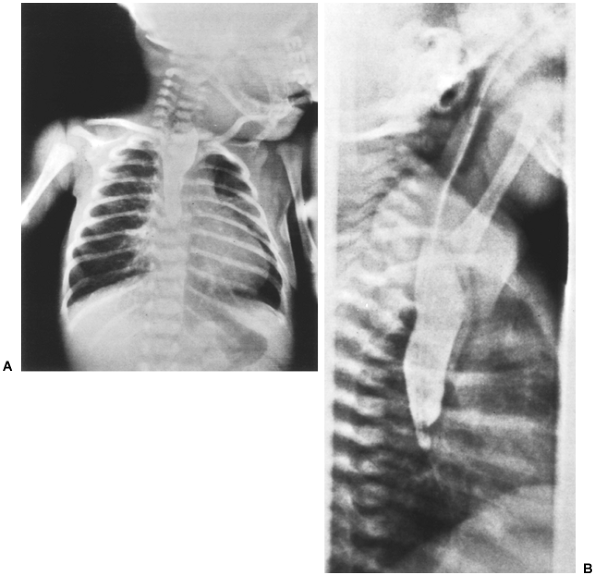 |
Fig. 139-15. Posteroanterior (A) and lateral projection (B) of an esophagogram revealing significant narrowing of the esophagus with proximal dilatation. This segmental hypertrophic congenital stenosis of the midesophagus responded well to repeated esophageal dilation. From Scherer LR, Grosfeld JL: Congenital esophageal stenosis, esophageal duplication, neurenteric cyst and esophageal diverticulum. In Ashcraft KW, Holder TM (eds): Pediatric Esophageal Surgery. Orlando, FL: Grune&Stratton, 1986, p. 53. With permission. |
Diagnosis and Differential Diagnosis
Both radiologic and endoscopic evaluations are useful in obtaining a diagnosis. A chest radiograph documents the location of the tip of an oral gastric tube and the presence of air in the gastrointestinal tract below the diaphragm, which is helpful in the evaluation of an esophageal web and associated anomalies. A barium esophagogram using an image intensifier, fluoroscopy, and cineradiography clarify the exact anatomic location of the lesion, allow for the evaluation of esophageal motility, and usually identify the presence of GER (Fig. 139-15). Bar-Maor and associates (1983) found that more than 90% of cases of congenital stenosis caused by tracheobronchial remnant occur in either the lower one-third or distal end of the esophagus. Congenital web presents as a sharp shelf at the point of obstruction, whereas the tracheobronchial remnant reveals an abrupt narrowing of the distal esophagus with proximal esophageal dilatation (Fig. 139-16). Endoscopy is another important diagnostic tool and may be a therapeutic modality as well. Endoscopy may demonstrate the presence of a lesser degree of stenosis, evidence of mucosal injury, or esophagitis due to GER. Biopsy or dilation of the esophagus may be performed if necessary.
GER may present as esophageal stenosis due to stricture, even in the young infant. Diagnostic evaluation should include pH probe testing, manometry, and scintigraphy if required to rule out reflux esophagitis. An adequate history reveals whether stenosis is due to caustic ingestion, which is more commonly observed in toddlers than in small infants. Radiologic study should precede endoscopy because occasionally a form of blind pouch may lie just beyond the stricture and, if not previously identified, may lead to esophageal perforation during endoscopy.
Treatment
The initial therapy for congenital esophageal stenosis is dilation. If the dilator passes easily, this can be continued first on a weekly basis, followed by bimonthly dilations and calibrations of the esophagus for several months thereafter, until the stenosis is resolved. At this time, the patient should be asymptomatic. Relief of the stricture should be documented by a contrast esophagogram.
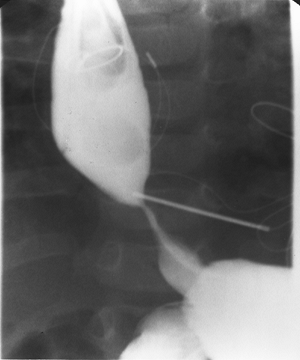 |
Fig. 139-16. Anteroposterior view of distal esophagus in a child with a tracheobronchial remnant. The esophagogram demonstrates the distal narrowing above the gastroesophageal junction and the proximal dilatation. |
If the bougie is difficult to pass, a balloon dilator can be attempted. If this is unsuccessful, a gastrostomy should be performed, followed by antegrade passage of a string through the gastrostomy site a week to 10 days later. Using the string as a guide, the stenosis is gently dilated with progressively larger tapered Tucker dilators.
Ishida (1969) and Anderson (1973) and their colleagues report that esophageal dilation has not been a successful method of treating stenosis because of tracheobronchial cartilaginous remnants and can actually be dangerous. Deiraniya (1974) reported one infant who died after esophageal perforation that followed dilation of stenosis because of a tracheobronchial remnant. The remnant of tracheobronchial tissue includes a circumferential crescent of cartilage around the stenotic portion that prevents stretching and may lead to perforation, as noted by Ibrahim and Sandry (1981) and Newman and Bender (1997). Surgical excision of the stenosis is required. Primary esophageal anastomosis is almost always possible. Takamizawa and associates (2002) recommended endoscopic ultrasound to differentiate a stenosis secondary to tracheobronchial remnants from one secondary to fibromuscular stenosis. Fibromuscular stenosis can usually be successfully treated with dilation alone. As Rose and associates (1975) have reported, the resection may be accomplished either by a thoracic (usually)
P.2138
or abdominal approach (occasionally), depending on the location of the lesion.
Huchzermeyer (1979) and Mares (1986) and their co-workers described the endoscopic treatment of an esophageal web, with electrocautery used to incise the web and an orogastric tube passed and esophageal dilation performed 1 week later.
DIVERTICULUM OF THE ESOPHAGUS
True diverticulum of the esophagus is an exceedingly rare congenital anomaly. A true diverticulum must contain esophageal mucosa and submucosa with complete muscular walls. The embryonic origin is uncertain, but it may be related to a persistent embryonic mucosal diverticulum, as reported by Lewis and Thyng (1907), or to the presence of a small, blind duplication, which subsequently enlarges by a mechanism similar to that noted with a pulsion diverticulum.
Clinical Presentation
First described in 1926 by Jackson and Shallow, esophageal diverticula usually present in late infancy and early childhood with signs and symptoms of recurrent respiratory infection and progressive dysphagia. In contrast, lesions in the pharyngoesophageal area that occur in the newborn period present with symptoms similar to those of esophageal atresia. Excessive salivation, regurgitation of formula, and cough with feedings are the most common presenting findings. A rare patient presents with cyanosis. Even more rare is a diverticulum associated with either a TEF or a diverticulum proximal to an esophageal stenosis.
Diagnosis
A barium esophagogram is the diagnostic method of choice for congenital diverticulum of the esophagus. It is important to obtain two views of the esophagus to confirm the diagnosis. Endoscopy is another important aid in the diagnosis of either a pharyngoesophageal or true esophageal diverticulum and may also detect an associated anomaly, such as TEF.
Treatment
Several methods of management of esophageal diverticula have been described, but surgical extirpation is the treatment of choice. DeBakey and co-workers (1952) described a single-stage procedure, which is still preferred today. The neck of the diverticulum should be allowed to develop before surgical repair, therefore allowing for adequate tissue for closure of the esophagus. The diverticulum should be freed to the level of its neck. Amputation of the diverticulum should allow for enough tissue to close the neck of the diverticulum without causing esophageal stenosis. To ensure this, the defect is closed in a transverse fashion.
Congenital diverticula are rare, and adequate data are relatively unavailable to evaluate the results of surgical therapy. Repair of a similar acquired pulsion diverticulum, however, is associated with a postoperative mortality rate of less than 1% and a recurrence rate of less than 5%.
REFERENCES
Allmendinger N, et al: Balloon dilation of esophageal strictures in children. J Pediatr Surg 31:334, 1996.
Anderson LS, et al: Cartilaginous esophageal ring: a cause of esophageal stenosis in infants and children. Radiology 108:665, 1973.
Azimi F, O'Hara HE: Congenital intraluminal mucosal web of the esophagus with tracheoesophageal fistula. Am J Dis Child 125:92, 1973.
Bar-Maor JA, et al: Congenital oesophageal stenosis due to cartilaginous tracheobronchial remnants. S Afr J Surg 21:43, 1983.
Bergman M, Charna RM: Tracheobronchial rests in the esophagus, their relation to some benign strictures and certain types of cancer of the esophagus. J Thorac Surg 35:97, 1958.
Bergmeijer JLJ, Hazebroek FW: Prospective medical and surgical treatment of gastroesophageal reflux in esophageal atresia. J Am Coll Surg 187:153, 1998.
Bremer JL: Diverticula and duplications of the intestinal tract. Arch Pathol 38:132, 1944.
Canty TG Jr, et al: Aortic arch anomalies associated with long gap esophageal atresia and tracheoesophageal fistula. J Pediatr Surg 32:1587, 1997.
Choudhury SR, et al: Survival of patients with esophageal atresia: influence of birth weight, cardiac anomaly and late respiratory complications. J Pediatr Surg 34:70, 1999.
Crisera CA, et al: Esophageal atresia with tracheoesophageal fistula: suggested mechanism in faulty organogenesis. J Pediatr Surg 34:204, 1999.
Davies MRQ: Anatomy of the extrinsic motor nerve supply to mobilized segments of the oesophagus disrupted by dissection during repair of oesophageal atresia with distal fistula. Br J Surg 83:1268, 1996.
DeBakey ME, Heancy JP, Creech O: Surgical considerations in diverticula of the esophagus. JAMA 150:1076, 1952.
Deiraniya AK: Congenital oesophageal stenosis due to tracheobronchial remnants. Thorax 29:720, 1974.
de Lorimier AA, Harrison MR: Long gap esophageal atresia: primary anastomosis after esophageal elongation by bougienage and esophagomyotomy. J Thorac Cardiovasc Surg 79:138, 1980.
Diez-Pardo JA, et al: A new rodent experimental model of esophageal atresia and tracheoesophageal fistula: preliminary report. J Pediatr Surg 31: 498, 1996.
Engum SA, et al: Analysis of morbidity and mortality in 227 cases of esophageal atresia and/or tracheoesophageal fistula over two decades. Arch Surg 130:502, 1995.
Evans KL, et al: Management of posterior laryngeal and laryngotracheoesophageal clefts. Arch Otolaryngol Head Neck Surg 121:1380, 1995.
Frey EK, Duschel L: Der Kardiospasmus. Ergeb Chirut Orthop 29:637, 1936.
Gray SW, Skandalakis JE: Embryology for Surgeons: The Embryological Basis for the Treatment of Congenital Defects. Philadelphia: WB Saunders, 1972.
Haight C: Some observations on esophageal atresias and tracheoesophageal fistulas of congenital origin. J Thorac Surg 34:141, 1957.
Harris J, Kallen B, Robert E: Descriptive epidemiology of alimentary tract atresia. Teratology 52:15, 1995.
Hof E, et al: Deleterious consequences of gastroesophageal reflux in cleft larynx surgery. J Pediatr Surg 22:197, 1987.
Holder TM, et al: Esophageal atresia and tracheoesophageal fistula: a survey of its members by the surgical section of the American Academy of Pediatrics. Pediatrics 34:542, 1964.
P.2139
Holder TM: Esophageal atresia and tracheoesophageal fistula. In Ashcraft KW, Holder TM (eds): Pediatric Esophageal Surgery. Orlando: Grune&Stratton, 1986.
Howard R, Myers NA: Esophageal atresia: a technique for elongating the upper pouch. Surgery 58:725, 1965.
Huchzermeyer H, Burdelski M, Hruby M: Endoscopic therapy of a congenital oesophageal stricture. Endoscopy 11:259, 1979.
Ibrahim NB, Sandry GJ: Congenital oesophageal stenosis caused by tracheobronchial strictures in the oesophageal wall. Thorax 36:465, 1981.
Ishida M, et al: Congenital esophageal stenosis due to tracheobronchial remnants. J Pediatr Surg 4:339, 1969.
Iuchtman M, et al: Morbidity and mortality in 46 patients with the VACTERL association. Isr J Med Sci 28:281, 1992.
Jackson C, Shallow TA: Diverticula of the esophagus: pulsion, traction, malignant and congenital. Ann Surg 83:1, 1926.
Jewsberry P: An unusual case of congenital esophageal stricture. Br J Surg 58:475, 1971.
Johnson FT: The development of the mucous membrane of the esophagus, stomach and small intestine in the human embryo. Am J Anat 10:521, 1910.
Kimura K, et al: A new approach for the salvage of unsuccessful esophageal atresia repair: a spiral myotomy and delayed definitive operation. J Pediatr Surg 22:981, 1987.
Kluth D: Atlas of esophageal atresia. J Pediatr Surg 11:901, 1976.
Kluth D, Steding G, Seidl W: The embryology of foregut malformations. J Pediatr Surg 22:389, 1987.
Lewis FT, Thyng FW: The regular occurrence of intestinal diverticula in embryos of the pig, rabbit and man. Am J Anat 7:505, 1907.
Lipshutz GS, et al: Anterior cervical approach for repair of laryngotracheoesophageal cleft. J Pediatr Surg 33:400, 1998.
Livaditis A, Radberg L, Odensjo G: Esophageal end-to-end anastomosis. Reduction of anastomotic tension by circular myotomy. Scand J Thorac Surg 6:206, 1972.
Manning PB, et al: Fifty years' experience with esophageal atresia and tracheoesophageal fistula beginning with Cameron Haight's first operation in 1935. Ann Surg 204:446, 1986.
Mares AJ, et al: Congenital esophageal stenosis. Transendoscopic web incision. J Clin Gastroenterol 8:555, 1986.
McKneally MF, et al: Surgical treatment of congenital esophageal atresia. Ann Thorac Surg 38:606, 1984.
Murphy SG, Yazbeck S, Russo P: Isolated congenital esophageal stenosis. J Pediatr Surg 30:1238, 1995.
Nambirajan L, et al: The value of early postoperative oesophagography following repair of oesophageal atresia. Pediatr Surg Int 13:76, 1998.
Newman B, Bender TM: Esophageal atresia/tracheoesophageal fistula and associated congenital esophageal stenosis. Pediatr Radiol 27:530, 1997.
Nishina T, Tsuchida Y, Saito S: Congenital esophageal stenosis due to tracheobronchial remnants and its associated anomalies. J Pediatr Surg 16:190, 1981.
Ohkawa H, et al: Lower esophageal stenosis in association with tracheobronchial remnants. J Pediatr Surg 10:453, 1975.
O'Rahilly R, Muller F: Respiratory and alimentary relations in staged human embryos. New embryological data and congenital anomalies. Ann Otol Rhinol Laryngol 93:421, 1984.
Pettersson G: Inhibited separation of larynx and the upper part of trachea from oesophagus in a newborn: report of a case successfully operated upon. Acta Chir Scand 110:250, 1955.
Quan L, Smith DW: The VATER association. Vertebral defects, anal atresia, T-E fistula with esophageal atresia, radial and renal dysplasia: a spectrum of associated defects. J Pediatr 82:104, 1973.
Replogle RL: Esophageal atresia: plastic sump catheter for drainage of the proximal pouch. Surgery 54:296, 1963.
Richter CF: Dissertatio medico de infanticido in artis obstetriciae [Thesis]. Leipzig, 1792.
Rose JS, et al: Congenital oesophageal strictures due to cartilaginous rings. Br J Radiol 48:16, 1975.
Roth B, et al: Laryngo-tracheo-esophageal cleft: clinical features, diagnosis, and therapy. Eur J Pediatr 140:41, 1983.
Ryan DP, et al: Laryngotracheoesophageal cleft (type IV): management and repair of lesions beyond the carina. J Pediatr Surg 26:962, 1991.
Scherer LR, Grosfeld JL: Congenital esophageal stenosis, esophageal duplication, neurenteric cyst and esophageal diverticulum. In Ashcraft KW, Holder TM (eds): Pediatric Esophageal Surgery. Orlando, FL: Grune&Stratton, 1986, p. 53.
Sidaway ME: Duplication of the esophagus. Ann Radiol 7:400, 1964.
Simpson BB, et al: Type IV laryngotracheoesophageal clefts: surgical management for long-term survival. J Pediatr Surg 31:1128, 1996.
Snyder CL, et al: Efficacy of partial wrap fundoplication for gastroesophageal reflux after repair of esophageal atresia. J Pediatr Surg 32:1089, 1997.
Spitz L, et al: Oesophageal atresia: at-risk groups for the 1990s. J Pediatr Surg 29:723, 1994.
Spitz L: Esophageal atresia: past, present and future. J Pediatr Surg 31:19, 1996.
Stephens HB: H-type tracheoesophageal fistula complicated by esophageal stenosis. J Thorac Cardiovasc Surg 59:325, 1970.
Stringer MD, et al: Prenatal diagnosis of esophageal atresia. J Pediatr Surg 30:1258, 1995.
Takamizawa S, et al: Congenital esophageal stenosis: therapeutic strategy based on etiology. J Pediatr Surg 37:197, 2002.
Tsai JY, et al: Esophageal atresia and tracheoesophageal fistula: surgical experience over two decades. Ann Thorac Surg 64:778, 1997.
Usui N, et al: Anomalies of the tracheobronchial tree in patients with esophageal atresia. J Pediatr Surg 31:258, 1996.
Vasudevan SA, et al: Management of esophageal stenosis. J Pediatr Surg 37:1024, 2002.
Vijayaraghavan SB: Antenatal diagnosis of esophageal atresia with tracheoesophageal fistula. J Ultrasound Med 15:417, 1996.
Waterston DJ, Carter REB, Aberdeen E: Oesophageal atresia: tracheo-oesophageal fistula: a study of survival in 218 infants. Lancet 1:819, 1962.
Yeung CK, et al: Congenital esophageal stenosis due to tracheobronchial remnants: a rare but important association with esophageal atresia. J Pediatr Surg 27:852, 1992.
EAN: 2147483647
Pages: 203